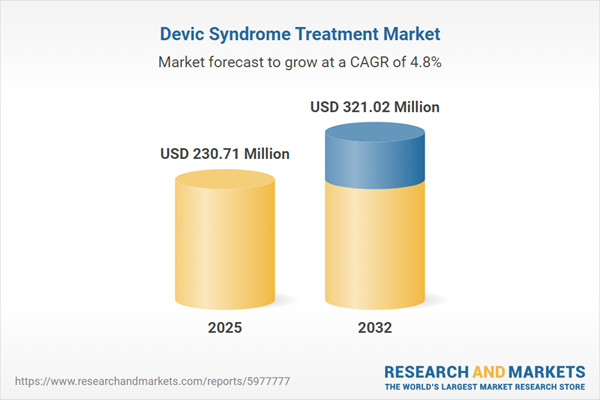Speak directly to the analyst to clarify any post sales queries you may have.
The Devic's Syndrome Treatment Market is advancing rapidly as new therapeutics and digital health solutions evolve in response to complex care needs and shifting supply chain realities. Senior decision-makers are confronted with both technological promise and regulatory shifts, demanding informed, agile strategies.
Market Snapshot: Growth Outlook for Devic's Syndrome Treatment Market
The Devic's Syndrome Treatment Market grew from USD 220.27 million in 2024 to USD 230.71 million in 2025. It is projected to sustain growth at a CAGR of 4.82%, reaching USD 321.02 million by 2032. This trajectory reflects expanding adoption of advanced biologics, innovative immunotherapies, and evolving stakeholder demands across global healthcare systems.
Scope & Segmentation
- Treatment Types:
- Corticosteroids: intravenous and oral administration
- Immunosuppressants: azathioprine, mycophenolate mofetil
- Monoclonal Antibodies: eculizumab, inebilizumab
- Plasma Exchange: automated, manual
- Supportive Therapy: pain management, physiotherapy
- Distribution Channels:
- Hospital pharmacies
- Online pharmacies
- Retail pharmacies
- End Users:
- Home healthcare services
- Hospitals
- Specialty clinics
- Regional Coverage:
- Americas: North America (United States, Canada, Mexico), Latin America (Brazil, Argentina, Chile, Colombia, Peru)
- Europe, Middle East & Africa: Europe (United Kingdom, Germany, France, Russia, Italy, Spain, Netherlands, Sweden, Poland, Switzerland), Middle East (UAE, Saudi Arabia, Qatar, Turkey, Israel), Africa (South Africa, Nigeria, Egypt, Kenya)
- Asia-Pacific: China, India, Japan, Australia, South Korea, Indonesia, Thailand, Malaysia, Singapore, Taiwan
- Key Stakeholders:
- Alexion Pharmaceuticals, Inc.
- F. Hoffmann-La Roche Ltd.
- Viela Bio, Inc.
- Chugai Pharmaceutical Co., Ltd.
- Teva Pharmaceutical Industries Ltd.
Key Takeaways: Executive Guidance for Decision-Makers
- Adoption of immunotherapies, particularly complement inhibitors and B-cell-depleting agents, has fundamentally altered clinical approaches and market positioning in this rare disease space.
- Rising demand for personalized care and precision medicine is encouraging investment in biomarker-guided treatment and novel patient monitoring solutions across all regions.
- Collaboration among industry, public agencies, and patient groups accelerates therapy development, optimizing patient access and outcome measurement from research to post-marketing stages.
- Regional disparities exist, with early technology uptake and local manufacturing driving market dynamics in developed economies, while reimbursement and infrastructure challenges persist in emerging regions.
- Competitive activity is increasing, with established and emerging biopharma firms forming partnerships and expanding therapy pipelines while health systems develop integrated support services.
Tariff Impact: Navigating New US Supply Chain Pressures
With the implementation of new United States tariffs on biologic inputs and therapeutics in 2025, supply chain strategies are shifting. Pharmaceutical producers are realigning sourcing and assembly toward domestic and near-shore operations to offset rising costs. Healthcare providers and payers are re-evaluating procurement and reimbursement agreements in response to longer lead times and higher unit prices. These shifts are intensifying negotiations for coverage and supporting new risk-sharing compensation models, impacting treatment accessibility across the country.
Methodology & Data Sources
This report integrates in-depth literature reviews, consultation with neurologists, pharmacoeconomists, and supply chain experts, and data triangulation from clinical and public health sources. A synthesized segmentation framework delivers multi-layered market perspectives. Robust quality controls and iterative feedback from stakeholders ensure credible, actionable insights.
Why This Report Matters
- Enables executives to align investment and resource allocation with current market drivers and disruptive influences in Devic's Syndrome Treatment.
- Provides evidence-based insights to support strategic planning around emerging therapies, supply chain mitigation, and regional market access optimization.
- Informs policy and operational decisions with up-to-date analysis of competitive dynamics, care delivery trends, and evolving regulatory paradigms.
Conclusion
The Devic's Syndrome Treatment Market is evolving through clinical innovation, operational resilience, and strategic collaboration. Equipped with this analysis, decision-makers can proactively address complexities and drive impactful growth across the treatment landscape.
Additional Product Information:
- Purchase of this report includes 1 year online access with quarterly updates.
- This report can be updated on request. Please contact our Customer Experience team using the Ask a Question widget on our website.
Table of Contents
3. Executive Summary
4. Market Overview
7. Cumulative Impact of Artificial Intelligence 2025
Companies Mentioned
The companies profiled in this Devic's Syndrome Treatment market report include:- Alexion Pharmaceuticals, Inc.
- F. Hoffmann-La Roche Ltd.
- Viela Bio, Inc.
- Chugai Pharmaceutical Co., Ltd.
- Teva Pharmaceutical Industries Ltd.
Table Information
| Report Attribute | Details |
|---|---|
| No. of Pages | 183 |
| Published | November 2025 |
| Forecast Period | 2025 - 2032 |
| Estimated Market Value ( USD | $ 230.71 Million |
| Forecasted Market Value ( USD | $ 321.02 Million |
| Compound Annual Growth Rate | 4.8% |
| Regions Covered | Global |
| No. of Companies Mentioned | 6 |









